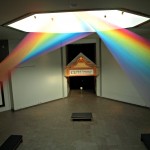The BYU Museum of Art officially unveiled its new centerpiece, Plexus NO. 29, on Thursday, Nov. 20.
Plexus NO. 29 will be on display through 2016. The centerpiece is part of artist Gabriel Dawe’s series of works, which includes more than 43 similar installations.
The curator of contemporary art Jeff Lambson said the MOA employees were excited to have Dawe because he is a “world-renowned artist with pieces across the globe.”
Dawe started creating his series in Dallas, eventually installing pieces in various countries across the world, including places in the United Kingdom, Italy, Copenhagen, France, Belgium and Mexico.
The series is characterized by a running spectrum of colored threads connected to several points along the walls and ceiling of the building it is designed in. This particular piece contains approximately 5,000 connections and creates a 3D, prism-like effect that gives Plexus NO. 29 a solid, yet almost imaginary appearance.
“What I like about this piece is that it is site specific,” Lambson said. “It metaphorically engages with the community. It was made for us.”
Lambson also said the piece reminds him of what President Kevin J. Worthen said at his inaugural speech, about BYU students becoming “etherealized.”
Ethereal is defined as “extremely delicate and light in a way that seems too perfect for this world,” a description that applies to Plexus NO. 29, which Dawe said is designed to “exist in the space between material and immaterial.”
“I’ve heard (what Gabriel does) described as threading light,” said Hillare Ashton, MOA marketing and public relations manager.

Light is a crucial aspect of Dawe’s work. Sunlight streaming through the window changes the piece, combining the individual threads into one large shape that dominates the ceiling of the MOA.
Dawe’s work is also “centered in the exploration of textiles, aiming to examine the complicated construction of gender and identity in his native Mexico and attempting to subvert the notions of masculinity and machismo prevalent in the present day,” according to his website. These are things Dawe experienced first-hand while growing up in Mexico.
Dawe was always interested in textiles, particularly when he was a young boy.
“My grandmother would teach my sister to embroider,” Dawe said. “She wouldn’t teach me. In my 20s I realized I had my own freedom to explore that. I’d always wanted to do something on a massive scale.”
The Plexus installations are also intended to embody the exploration of relationships between fashion and architecture. Dawe said that his interest in textiles inspired him to take the fabrics and threads of fashion and place them in an architectural setting.
He started creating the installations with deliberate gradients of color in mind. Gradually that changed to incorporate the whole spectrum. Some of his works include half or a third of the spectrum, but there is always a connection to the entire range of colors.
Dawe has lived in Canada, Texas and Mexico. He received his MFA from the University of Texas at Dallas, where he was a resident artist in the Artist in Residency program at UTD.
According to his website biography, his work has been globally recognized, appearing in publications around the world, “including Sculpture magazine, the cover of the 12th edition of Art Fundamentals published by McGraw-Hill and in author Tristan Manco’s book Raw + Material = Art.”
Students visiting the MOA will not walk pass this piece without noticing its complexities and movement. The centerpiece is worth much more than a passing glance.
“The average work of art holds the viewer for, what, two seconds?” Lambson said. “(Plexus NO. 29) becomes a kinetic work. It makes you move. It engages you.”







